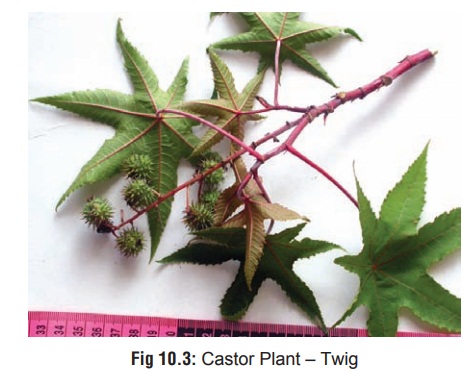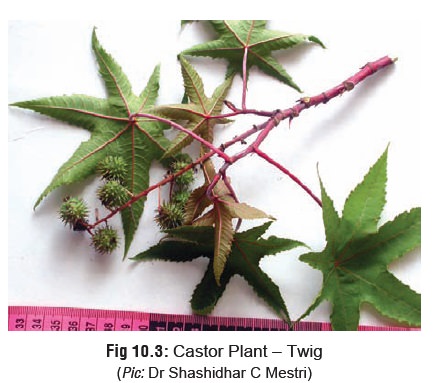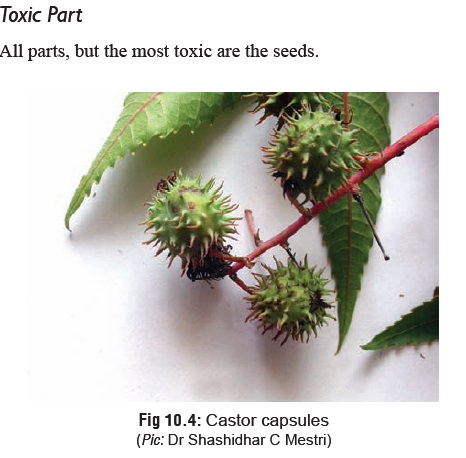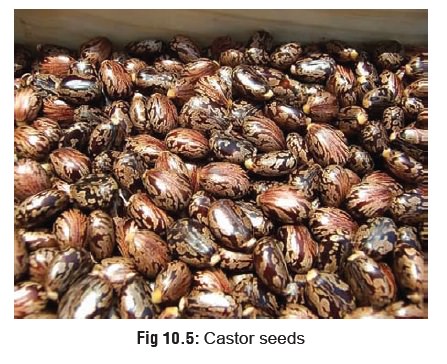Chapter: Modern Medical Toxicology: Organic Poisons (Toxins): Irritant Plants
Castor - Gastric Irritant Plants

Gastric Irritant Plants
Castor
Other Common Names
Mole
bean; Moy bean; Palma Christi.
Botanical Name
Ricinus communis.
Physical Appearance
·
This plant belonging to family
Euphorbiaceae, is a vigorous, perennial, erect, branched plant (Fig 10.3), and is native to India, but
is also encountered throughout the world in temperate and tropical climates.
Dwarf forms are typically less than 2 metres in height, but most plants become
tree-like with stout, fibrous roots and soft, woody, stems reaching a height of
6 to 9 metres.

·
Stems and branches may be flushed
red or maroon.
·
Leaves have long, green or reddish
stalks, and may be quite large (up to 1 metre across). They are generally
notched into 5 to 11 palmate lobes with toothed margins.
· Clusters of greenish-white to rust coloured flowers form at the end of the branches on 6 to 12 inch long upright stems. Male and female flowers are separate, but on the same plant.
·
The fruit (seed pod) has a prickly
capsule (Fig 10.4) and contains
(usually) three shiny, mottled, hard-coated, greyish-brown seeds (Fig 10.5). Seed pods are green or red,
about one inch long, and hold elliptical, glossy seeds, which may be mottled
with black, brown, grey, or white colours, and are 1 to 2 cm in length.


Uses
1.
Ornamental plant.
2.
Oil extracted from the seeds is used
medicinally as a purga-tive, and as a lubricant for engines.
3.
Castor beans have found wide use,
both systemically and topically, in stimulating breast milk production in many
countries.
4.
Ricin (the main active principle)
has been used as a chemical warfare agent, a reagent for pepsin and trypsin, an
experimental antitumour and immunosuppressive agent, and as a commercial mole
killer.
Toxic Part
All parts, but the most toxic are the seeds.
Toxic Principle
·
The main toxic principle is the
phytotoxin ricin which is a
toxalbumen. It is not present in castor oil which contains a much milder
irritant—ricinoleic acid. Ricin is
one of the supertoxic poisons of plant origin.*
·
Toxalbumens cause severe gastrointestinal lesions with
irritation of the oropharynx, oesophagus, or stomach when directly exposed.
Although clinically similar to alkaline caustic burns, they are usually delayed
two or more hours after exposure. Late complications result from cytotoxic
effects on the liver, central nervous sytem, kidney, and adrenal glands,
typically 2 to 5 days after exposure. The patient may be asymptomatic during
the preceding 1 to 5 days.
Mode of Action
·
The seeds are harmless when ingested
whole, since the outer coating resists digestion. However, if the seeds are
crushed or chewed before swallowing, toxicity results due to the release of
ricin. Poisoning is much more severe when ricin is injected parenterally.
·
Ricin contains two polypeptide
chains (A and B) held together by a single disulfide bond; the total molecular
weight is 66,000. Chain B is a lectin that binds to the surface of the cell to
facilitate toxin entry into the cell. Chain A disrupts protein synthesis by
activating the 60S ribosomal sub-unit. Sensitisation to castor bean (IgE
response) may occur, with the main allergen being a 25 storage albumin
(proposed name Ric cI). Both Type 1 (immediate) and Type IV (delayed) reac-
tions have been reported.
·
Haemagglutination has been seen in
animal and laboratory work, but is almost never seen in actual poisonings. It
is now believed that the haemagglutinating agent is not ricin, but another
lectin (sometimes called ricine).
·
The pulp of the seed contains
allergenic glycoproteins which cause allergic dermatitis, rhinitis, and asthma
in sensitised individuals.
Clinical Features
1. There is usually a delay of several
hours before manifesta-tions begin. There is at first a burning sensation in
the GI tract which is followed by colicky abdominal pain, vomiting, and
diarrhoea. Frequent stools, including bloody diarrhoea and tenesmus, are well
known signs of toxalbumin toxicity.
2.
In severe cases, there is
haemorrhagic gastritis and dehydra-tion. Urea nitrogen, amino acid hydrogen,
and inorganic phosphate levels are usually elevated.
3.
Delayed CNS toxicity may occur,
especially involving the cranial nerves. Optic nerve damage has been reported
with ricin.
4.
Renal damage leads to acute renal
failure. Haematuria is often seen. Serum creatinine is usually elevated.
5.
Liver damage may occur in serious
overdoses.
6.
![]() Major alterations in glucose
metabolism have been shown to occur in experimental ricin intoxication.
Glycogen stores decrease, gastrointestinal absorption of glucose decreases, and
glucose concentrations fall.
Major alterations in glucose
metabolism have been shown to occur in experimental ricin intoxication.
Glycogen stores decrease, gastrointestinal absorption of glucose decreases, and
glucose concentrations fall.
Usual Fatal Dose
·
It is generally believed that
ingestion of a single castor seed can be lethal, whereas actually 8 to 10 seeds
are required to produce a fatal outcome. However, even a single seed can
occasionally cause death due to anaphylaxis.
·
Parenteral injection of ricin can be
fatal with a dose as low as 1 mg/kg body weight. But even ricin is a poorly
absorbed substance, and it may take up to 5 days for toxic effects to manifest
fully.
Treatment
The
latent period between exposure and systemic symptoms requires observation for 8
hours following any substantial exposure to ricin.
1.
Decontamination:
stomach wash, activated charcoal,catharsis.
2.
Supportive
measures: IV fluids, monitoring for hypogly-caemia, haemolysis, and
complications of hypovolaemia. Alkalinisation of urine probably has a role in
preventing crystallisation of haemoglobin, and should be considered in severe
poisonings.
3. Many antidotes have been
investigated, but no specific treatments are available for toxalbumen
exposures. Various antibodies have been developed, but are not used clinically.
Forensic Issues
·
Reports from some countries suggest
that it is not unusual to find a clustering of cases of toxic gastroenteritis
among young children who ingest the seeds of castor. It is presumed that the
unique marbled pattern of the seeds may be very attractive to children, and
that the multiple seeds found in the pod may be shared between several
children.
·
The exaggerated notion about the
lethality of castor (and more particularly ricin) stems from the celebrated
case of Georgi Markov:
Georgi Markov (Fig 10.6) was a 49 year old Bulgarian who had defected to the West, and was working as a broadcaster for the BBC World Service in London. On September 7, 1978, he was waiting for his evening bus home on Waterloo Bridge when a sharp jab in his right thigh caused him to turn in surprise. The man behind him dropped his furled umbrella (the tip of which had appar- ently accidentally poked into him), apologised, and moved away. He subsequently hailed a taxicab and left the scene. Puzzled and a little concerned, Markov caught his bus home. Late that night he fell ill with fever and vomiting. Next morning, his wife called their family doctor over who became quite alarmed at Markov’s condition and rushed him to hospital. By now there was suspicion that his illness was connected somehow to the incident at the bus stop the previous day. The puncture wound in his thigh had become inflamed and painful. The body temperature rose relentlessly and septicaemia was diagnosed. Over the weekend Markov became delirious, passed into coma, and died shortly thereafter.

· Owing to the circumstances of the
death, a high-level police investigation was launched. An autopsy was ordered,
during the course of which the tissues around the puncture wound in the thigh
were dissected and revealed the presence of a tiny pellet, the size of a
pinhead. Electron microscopy revealed the pellet (made of an alloy of platinum
and iridium) to have two small holes bored through it (Fig 10.7). To drill holes 0.35 mm wide in a pellet of 1.5 mm
diameter, made of a notably hard substance, plainly indicated the involvement
of someone with access to highly specialised equipment. The position of the
pellet in the body suggested that the mysterious assailant’s umbrella must have
also been equally specialised. Investigators surmised that there must have been
a firing device in the ferrule, silently powered by a gas cylinder.

Chemical analysis of the pellet did not reveal the pres-ence of any poison. However, experimental injection of laboratory animals with a few of the known “supertoxic” poisons suggested the possibility of ricin. The negative chemical analysis only reinforced this possibility, since ricin is known to get degraded rapidly in the body leaving behind no trace of its original presence.
The
assassin with his lethal umbrella was never caught.
·
Castor oil ingestion during pregnancy can cause
terato-genic effects. Moderate growth retardation, craniofacial dysmorphia,
absence deformity of limbs, vertebral segmentation defect, and seizures have
been describedin
one case.
Related Topics